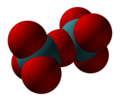 Structural formula of technetium(VII) oxide. | |||
 Unit cell of technetium(VII) oxide. | |||
| |||
| Names | |||
|---|---|---|---|
| IUPAC name Technetium(VII) oxide | |||
| Other names Technetium heptoxide | |||
| Identifiers | |||
| |||
3D model (JSmol) | |||
| ChemSpider | |||
PubChem CID | |||
CompTox Dashboard (EPA) | |||
| |||
| |||
| Properties | |||
| Tc2O7 | |||
| Molar mass | 307.810 g/mol | ||
| Appearance | light yellow solid | ||
| Density | 3.5 g/cm3 | ||
| Melting point | 119.5 °C (247.1 °F; 392.6 K) | ||
| Boiling point | 310.6 °C (591.1 °F; 583.8 K) | ||
| hydrolysis to HTcO4 | |||
| −40.0·10−6 cm3/mol | |||
| Structure [1] | |||
| Primitive orthorhombic | |||
| Pbca, No. 61 | |||
| Hazards | |||
| Occupational safety and health (OHS/OSH): | |||
Main hazards | radioactive | ||
Except where otherwise noted, data are given for materials in their standard state (at 25 °C [77 °F], 100 kPa). | |||

Technetium(VII) oxide is the chemical compound with the formula Tc2O7. This yellow volatile solid is a rare example of a molecular binary metal oxide, the other examples being RuO4, OsO4, and the unstable Mn2O7. It adopts a centrosymmetric corner-shared bi-tetrahedral structure in which the terminal and bridging Tc−O bonds are 167pm and 184 pm respectively and the Tc−O−Tc angle is 180°. [2]
Technetium(VII) oxide is prepared by the oxidation of technetium at 450–500 °C: [3]
- 4 Tc + 7 O2 → 2 Tc2O7
It is the anhydride of pertechnetic acid and the precursor to sodium pertechnetate:
- Tc2O7 + 2 H2O → 2 HTcO4
- Tc2O7 + 2 NaOH → 2 NaTcO4 + H2O

